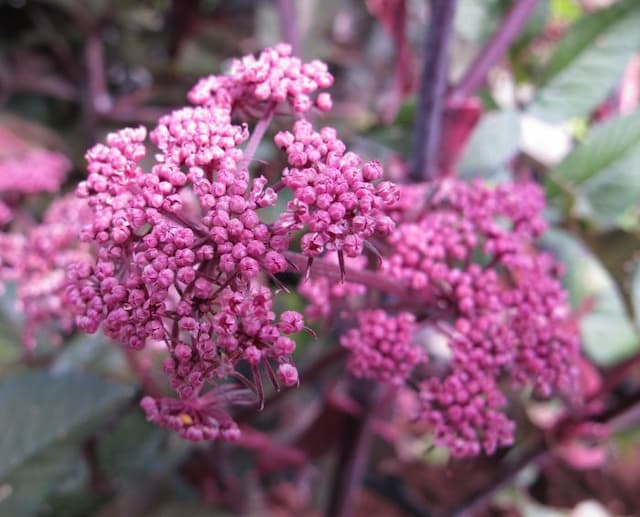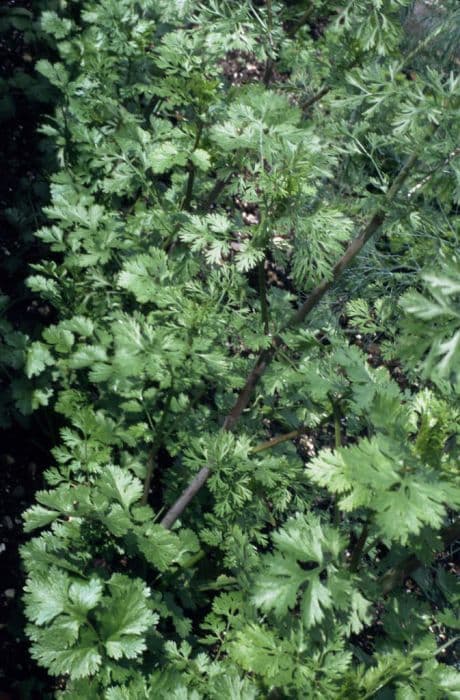Bronze Fennel Foeniculum vulgare 'Purpureum'

ABOUT
Commonly known as bronze fennel, this plant is striking due to its feathery, almost whimsical foliage that displays a rich array of purple and bronze hues. The delicate, finely divided leaves are arranged on slender stems, creating an airy and graceful appearance. When in bloom, it produces umbels of tiny yellow flowers that add a splash of bright color contrasting beautifully with the darker foliage. These blossoms are particularly attractive to a variety of pollinators. The overall aesthetic of bronze fennel is one of a soft, textured, and colorful addition to any garden space, notable for its unique coloration and feathery texture.
About this plant
 Names
NamesFamily
Apiaceae.
Synonyms
Bronze Fennel, Purple Fennel, Sweet Fennel.
Common names
Foeniculum officinale, Anethum foeniculum, Anethum panmori, Anethum rupestre, Foeniculum capillaceum, Foeniculum divaricatum, Foeniculum dulce, Foeniculum foeniculum, Foeniculum giganteum, Foeniculum panmorium, Foeniculum piperitum, Foeniculum sativum, Ligusticum foeniculum, Meum foeniculum, Ozodia foeniculacea, Selinum foeniculum, Seseli foeniculum, Tenoria romana.
 Toxicity
ToxicityTo humans
Fennel (Foeniculum vulgare 'Purpureum') is generally regarded as safe for human consumption and is widely used as a culinary herb. However, some individuals may experience allergic reactions, and eating fennel in large amounts could potentially lead to phytophotodermatitis, a condition caused by exposure to plant compounds followed by sunlight which results in skin inflammation. Overconsumption may also have an estrogenic effect due to the presence of phytoestrogens, which could potentially cause hormonal imbalances. Nevertheless, for a majority of the population, fennel is not toxic and is safe to consume in normal food quantities.
To pets
Fennel is considered non-toxic to pets such as dogs and cats. This plant, which includes the variety Foeniculum vulgare 'Purpureum', is not listed among the toxic plants for common household animals. However, as with any food that is not a normal part of a pet's diet, fennel may cause digestive upset in some animals if ingested in large amounts. This could potentially lead to symptoms such as diarrhea or vomiting. Therefore, while fennel is not poisonous, moderation is important when offering it to pets.
 Characteristics
CharacteristicsLife cycle
Perennials
Foliage type
Deciduous
Color of leaves
Green
Flower color
Yellow
Height
4 feet (1.2 meters)
Spread
3 feet (0.9 meters)
Plant type
Herb
Hardiness zones
5
Native area
Mediterranean
Benefits
 General Benefits
General Benefits- Aesthetic Appeal: The Foeniculum vulgare 'Purpureum', commonly known as Bronze Fennel, adds striking purple foliage to a garden, providing a colorful contrast to green plants.
- Culinary Use: The leaves, seeds, and bulbs of Bronze Fennel are used in a variety of dishes for their aniseed-like flavor, enhancing the taste of salads, fish, and other culinary recipes.
- Attracts Wildlife: The plant's flowers attract beneficial insects such as bees and butterflies, promoting pollination in the garden.
- Companion Planting: Bronze Fennel can be planted alongside other plants to help deter pests naturally, supporting an environmentally friendly approach to gardening.
- Easy Maintenance: It is a hardy and low-maintenance perennial herb, making it an excellent choice for gardeners of all skill levels.
- Herb Garden Addition: As a versatile herb, it is an essential addition to any herb garden for both its aesthetic qualities and its usefulness in cooking.
- Edible Flowers: The flowers of the Bronze Fennel are edible and can be used as a garnish or flavoring agent in a variety of dishes.
 Medical Properties
Medical Properties- Antispasmodic - It is often used to relieve smooth muscle spasms, particularly in the gastrointestinal tract.
- Carminative - Fennel is traditionally used to help alleviate gas and bloating.
- Diuretic - The plant may increase the rate of urine production, aiding in the removal of excess fluids from the body.
- Anti-inflammatory - Compounds in fennel may help reduce inflammation, which can be beneficial for various conditions.
- Galactagogue - It is known to possess properties that can increase the production of breast milk in nursing mothers.
- Antimicrobial - Fennel has shown potential in fighting certain strains of bacteria and fungi.
- Expectorant - It is used to help loosen and expel phlegm from the respiratory tract.
- Antioxidant - Fennel contains various antioxidants that may help protect cells from oxidative stress.
 Air-purifying Qualities
Air-purifying QualitiesThis plant is not specifically known for air purifying qualities.
 Other Uses
Other Uses- Foeniculum vulgare 'Purpureum', commonly known as Bronze Fennel, can be used as a natural dye, imparting a yellowish to green hue to fabrics.
- The fluffy foliage of Bronze Fennel can serve as an attractive backdrop in floral arrangements or as filler in bouquets.
- The dried stems of the Bronze Fennel can be used in crafts, such as homemade wreaths or as a part of decorative dried arrangements.
- Bronze Fennel's strong aroma can deter pests in the garden when planted as a companion plant amidst vegetables and flowers.
- When used in a sensory garden, the foliage of Bronze Fennel provides a unique texture and color contrast that can be visually and tactilely stimulating.
- The seeds of Bronze Fennel can be included in homemade potpourris for their fragrance and decorative appearance.
- The hollow stems of mature plants can be cut and used as natural straws for garden party drinks.
- Bronze Fennel leaves can be used to wrap and infuse food, such as fish or cheese, with a delicate anise flavor during cooking.
- Small birds, such as finches, are attracted to the seeds of the Bronze Fennel, making it a plant of choice for bird watchers to include in their gardens.
- As a natural mulch, the fine, feathery foliage of Bronze Fennel can be spread over the soil to help retain moisture and suppress weeds.
Interesting Facts
 Feng Shui
Feng ShuiThe Bronze Fennel is not used in Feng Shui practice.
 Zodiac Sign Compitability
Zodiac Sign CompitabilityThe Bronze Fennel is not used in astrology practice.
 Plant Symbolism
Plant Symbolism- Strength: Foeniculum vulgare 'Purpureum', commonly known as Bronze Fennel, often symbolizes strength, due to its sturdy stems and hardy nature, indicating the ability to withstand various conditions.
- Longevity: This plant can live for several years, representing the endurance of life and vitality over time.
- Healing: Historically used for medicinal purposes, Bronze Fennel is commonly associated with healing and the soothing of ailments.
- Protection: In many cultures, fennel was used to ward off negative forces, thus it is viewed as a symbol of protection against harm.
- Purification: The aromatic nature of the plant associates it with purification, suggesting the cleansing of both the air and the spirit.
 Water
WaterBronze Fennel should be watered thoroughly, allowing the soil to dry out slightly between waterings. Aim to water this plant once a week, providing about 1 to 1.5 inches of water each time, which equates to roughly 0.5 to 0.9 gallons depending on the plant's size and the soil conditions. Overwatering should be avoided as it can lead to root rot, especially in poorly draining soils. The plant prefers a consistent watering schedule; however, established plants are somewhat drought-tolerant and can withstand short periods of dryness.
 Light
LightBronze Fennel thrives best in full sun conditions, which means it needs at least 6 hours of direct sunlight per day. The ideal spot for this plant is in a location that is exposed to unfiltered sunlight throughout the day. If grown indoors, a south-facing window would be the most suitable place to provide enough light for healthy growth.
 Temperature
TemperatureBronze Fennel prefers temperatures between 50°F and 75°F, making it well-suited for temperate climates. The plant is hardy and can tolerate a minimum temperature down to around 15°F, but anything below this can cause damage or kill the plant. This herbaceous perennial fares best when the temperature does not exceed the high 70s Fahrenheit, and it can survive through winter in many regions without protection.
 Pruning
PruningPruning Bronze Fennel is done primarily to maintain its shape, remove dead or damaged stems, and encourage new growth. It can be pruned in early spring before new growth starts or after harvesting the leaves. Generally, cut back the older woody stems by one-third to one-half. Pruning is recommended once yearly, or as needed to control the plant's size and remove any unwanted seed heads that may lead to excessive self-sowing.
 Cleaning
CleaningAs needed
 Soil
SoilBronze Fennel prefers well-draining, fertile soil with a pH range of 6.0 to 7.0. A mix of garden soil, peat, and perlite or sand can create an ideal environment for growth.
 Repotting
RepottingBronze Fennel typically does not require frequent repotting; it should be repotted every 2 to 3 years or when it becomes root-bound.
 Humidity & Misting
Humidity & MistingBronze Fennel thrives in a range of humidity conditions and does not have specific humidity requirements, making it versatile and easy to grow in various environments.
 Suitable locations
Suitable locationsIndoor
Place in full sun near a window and ensure good airflow for Bronze Fennel.
Outdoor
Full sun, well-draining soil, and space to accommodate its growth.
Hardiness zone
4-9 USDA.
 Life cycle
Life cycleFoeniculum vulgare 'Purpureum', commonly known as Bronze Fennel, begins its life as a seed; when provided with adequate conditions of soil, water, and light, the seed germinates. Upon germination, it emerges as a seedling and starts establishing its delicate, feathery foliage which transitions from a green to a striking bronze-purple color. As it grows to maturity, Bronze Fennel develops a sturdy stem and reaches heights up to 6 feet, with its leaves becoming a key identifying feature, along with its characteristic anise-like aroma. During the flowering stage, it yields umbels of small yellow flowers, which are attractive to a variety of pollinators including bees and butterflies. Following pollination, the plant sets seeds that can be harvested for culinary purposes or for replanting. After setting seeds, the plant completes its annual cycle, typically dying back in colder temperatures, although it can behave as a perennial in warmer climates.
 Propogation
PropogationPropogation time
Spring-Early Summer
Foeniculum vulgare 'Purpureum', commonly known as Bronze Fennel, is most popularly propagated by seed. For successful propagation, the best time is late winter to early spring. To propagate Bronze Fennel by seed, sow the seeds directly into the garden after the danger of frost has passed, or start them indoors 4 to 6 weeks before the last expected frost. Lightly cover the seeds with soil as they need some light to germinate, and keep the soil evenly moist. Seeds typically germinate within 7 to 14 days at a temperature of 60-70°F (15.6-21.1°C). Once the seedlings have developed true leaves and are strong enough to handle, they can be transplanted to their final location in the garden, ensuring they have full sun and well-drained soil for optimum growth.








